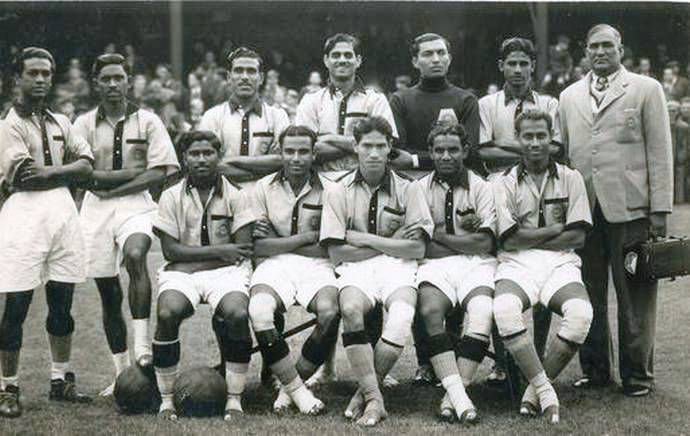Did India really refuse to play the 1950 FIFA World Cup because FIFA did not allow them to play barefoot?
Football may be the most popular sport in the world, and FIFA the most well-known sports organisation, but in most of India, from the streets of Mumbai to the fields of Ludhiana, children will pick up their bats and line up in front of some form of wickets, be it a few cans of soda or wickets drawn onto a wall. Their opposition will steady to run up a pitch, with a ball in hand, it could be made of plastic or cork. While the rest of the players will spread across floors, concrete, grass or AstroTurf, positioning themselves in anticipation of what is to come, a six, a four or perhaps, a catch, with shoes or barefoot, it doesn’t matter.
After all, cricket rules India, most of India anyway. You know when the Poms talk about breathing, living and feeling football, you get a sense of their love for the sport, but in India, barring the cliché of cricket is religion and the likes. Cricket is life, cricket is family and cricket is love, first love, for many and football,

On the other side of the sporting spectrum lies the most popular sport in the world – football. Yes, yes, ‘soccer’ for the Aussies and the Americans, but football, as it is, truly loved and admired by billions around the world. In India though, football’s popularity is a tough nut to crack. It is growing steadily, but it does not even come close to the sort of hysteria that a game akin to the El Classico can cause amongst fans.
On another day, this could have been very different. Why you might ask? Well, the Indian National Football did qualify for a FIFA World Cup once.
However, they refused to play after FIFA banned barefoot play following the 1948 Summer Olympics! They could not ‘bear’ the thought of having to play with shoes, so much so that they pulled out of the tournament itself!
That’s what a lot of people would have you believe anyway. Sailen Manna, the would-be captain at the tournament, even stated that Indian players did not have any problem with wearing shoes when playing football
First, let’s take it back a notch before discussing the topic any further. It was the summer of 1948, and the Indians faced off against the French in the preliminary round of the football tournament at the Olympics, mostly barefooted. The location, Ilford, to the east of London, 17,000 people in the crowd, Indians, Brits and the French included.
READ ABOUT INDIA’S BOLLYWOOD SPORTS STORIES HERE
After René Courbin scored the opening goal in the 30th minute, the game treaded on till the 70th when Sarangapani Raman scored India’s first-ever international goal to equalise! 19 minutes later though, horror - for the Indians.
Minutes before the blow of the full-time whistle, Frenchman, René Persillon scored! The Les Bleus won and the rest was history. At least for Indian footballing dreams. Or was it?
Lo and behold! The 1950 World Cup was set to take place across the oceans on the East Coast of Brazil. Political concerns of the time resulted in several teams pulling out of the tournament like the Soviet Union and Czechoslovakia. Other nations such as Argentina and Ecuador withdrew after qualifying.
Of the 4 teams invited to play in the tournament from Asia, the Philippines, Indonesia and Burma withdrew from the tournament as well, allowing the Indians to feature without competing. India was ranked 36th at the time and was quite the footballing force in Asia. Yet, according to what people would have you believe, they pulled out due to the barefoot ban.
Talimeren Ao on the left, leading the Indian team to Cricklefield Stadium to play against France, on 31st July 1948.
8 players out of 11 played barefoot but 3 players including Taj Mohammed (on the right in the picture) wore boots though the weather was dry.
The truth is that there have been several competing and diverse reasons for India’s absence at the 1950 World Cup.
Sailen Manna, the would-be captain at the tournament, even stated that Indian players did not have any problem not playing shoeless when playing football, in fact, they often did so, for example, when it rained they were forced to put their boots on due to the softening of the ground.
Meanwhile, Sports Illustrated’s Arindam Basu stated that the All India Football Federation (AIFF) did not value the World Cup, or perhaps, understand its importance.
He goes onto say that it was, their ambition to win the Asian Games that led to the apathy towards competing at the World Cup.
After all, in those days, it was by no means a global phenomenon.
It has also been argued that it was instead their focus on winning the Olympics, as that was the be-all and end-all of the time. The competition was held in high regard by all the major nations of the world, and the glamour, glitz and reward did lay in winning a Gold for your nation and not in lifting the World Cup.
Others have stated that the ‘perilous and enduring’ journey to Brazil from India was deemed to be too expensive and too long for the AIFF.
This claim has been disregarded though, as FIFA offered to pay the majority of India’s travel expenses to play. Let’s be honest, FIFA wanted India to play.
Having a newly formed nation, with hundreds of millions of people play, was a mouthwatering opportunity that FIFA wanted to capitalise on.
At the end of the day, India pulled out. Perhaps it was due to one of the reasons above (the barefoot ban included) or perhaps it was based on an amalgamation of the discussed reasons. Either way, India withdrew. They then faced the wrath of FIFA, who banned them from competing in the qualifiers for the next world cup.
Nations like Iran, Japan and more recently, Australia went onto become the frontrunners of the sport in Asia, as India continued to diminish. Today, India sits at a measly ranking of 103, and although there is hope for growth and progress in the Indian world of football, with the launch of the Indian Super League, there is still a very long way to go.
Meanwhile, cricket has become the holy grail for all the ambitious athletes in the country. The likes of Sunil Gavaskar, Sachin Tendulkar and Virat Kohli were and are idolised by millions around the country. Adding to that, the launch of the Indian Premier League earlier this decade has resulted in exorbitant TV rights, sponsorship deals, and monetary opportunities that have made cricket the ultimate sport in India, with no competitor even coming close.
This, of course, could have been a very different story, if India had played the World Cup, 69 years ago, barefoot or not. Alas, it was not meant to be, and we as fans of the sport will never truly know what could have been if the soon-to-be largest nation in the world had graced Brazil’s stadiums’ with its presence.

